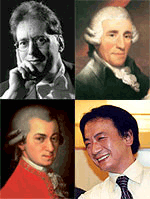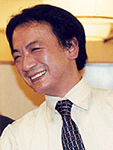Brief Interview of Eisuke Tsuchida for PTNA Festival
 PTNA Piano Festival will be held on 24th August, having two distinguished professors as lecturers: Prof.Robert Levin (US) and Prof. Eisuke Tsuchida. Here is a brief interview of Prof.Tsuchida, talking about his plans and points of the lecture.
PTNA Piano Festival will be held on 24th August, having two distinguished professors as lecturers: Prof.Robert Levin (US) and Prof. Eisuke Tsuchida. Here is a brief interview of Prof.Tsuchida, talking about his plans and points of the lecture.
-PTNA Piano Festival will be held on 24th August and you will talk about Haydn and Mozart for two hours. How do you prepare for this lecture?
Prof. Eisuke Tsuchida (T) :I would like to make brief introduction of the music of Haydn and Mozart, by comparative research between two composers in order to explore how they are unique and interesting. I am now studying again the complete sonatas of Haydn, including early pieces which are rarely played, to explore the distinctive characteristics in Haydn's music.
-What is the characteristics of Haydn's music?
T:Especially, the "surprising" elements in his music. Haydn avoided the mediocrity and always sought for dynamism and unique way of expression. He tried to be detached from the expression, in order to 'produce' it. It intensified his masculine, non-sentimental personality.
'Persistence' is another keyword to decipher his music. For instance, he focused on one of the rythms and repeated it again and again, but soon after, he turned his head aside or even ignore it. It was quite different from the seriousness of Beethoven.
- And what about Mozart?
 T:His music is rather operatic. While Haydn tended to persist with one motif / theme in his music, Mozart always sought for something new. Therefore, he created new themes one after another and didn't continue one motif long. Furthermore, compared to Haydn, Mozart was rather self-intoxicated, and tended to put himself into the music while he was writing.
T:His music is rather operatic. While Haydn tended to persist with one motif / theme in his music, Mozart always sought for something new. Therefore, he created new themes one after another and didn't continue one motif long. Furthermore, compared to Haydn, Mozart was rather self-intoxicated, and tended to put himself into the music while he was writing.
-How are you going to organize your 2 hours lecture?
T:The outline is as follows; First I will compare the Haydn Sonata Hob.XVI:50 (2 movt.) and Mozart Sonata KV.310 (2movt.), which will show you the apparent difference between two composers in regards of their personality and composition techniques. Then, I will take up Haydn Sonata Hob.XVI:48 (1movt.) to verify his characteristics of 'surprise' and 'persistence'. I will also try to make experiment of re-writing those unusual parts in 'ordinary' way.
On the other hands, I will probably choose Mozart Sonata KV.333 (3 movt.) to play in concerto style, to explain what makes his music as operatic.
In the end, I wll make another experiment. That is, to exchange their composition techniques by putting one to the other, and see how they were unique themselves.